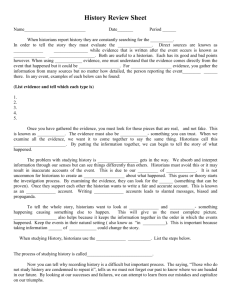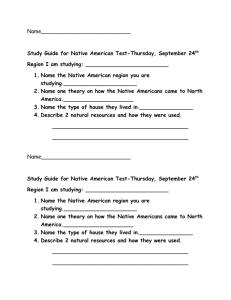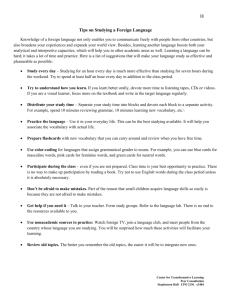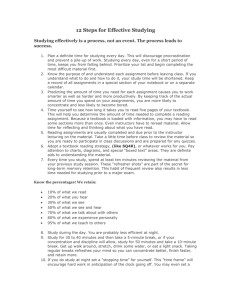Why do we use primary and secondary sources?
advertisement
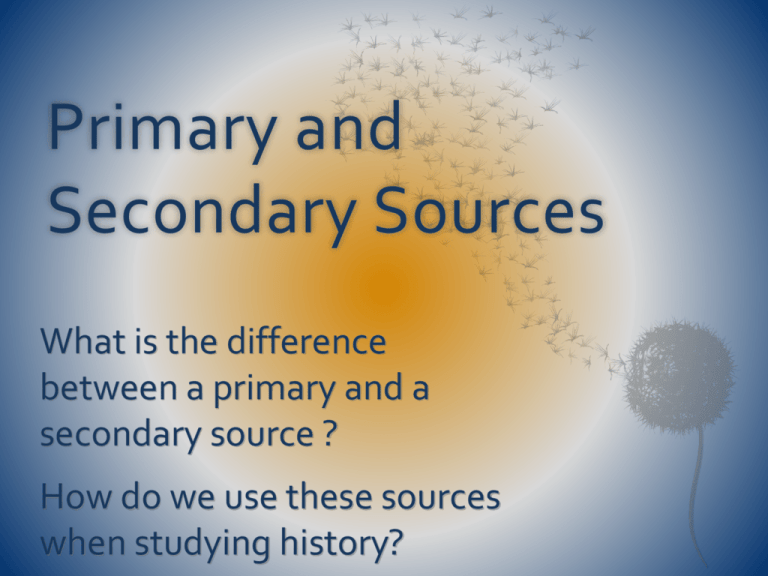
Primary and Secondary Sources What is the difference between a primary and a secondary source ? How do we use these sources when studying history? Why do we use primary and secondary sources? Historians use primary sources to develop questions and ideas about history, to draw conclusions, and to learn and teach about the past. Primary Sources: If you have ever looked at a picture of one of your ancestors, or if you have heard a speech from Dr. Marin Luther King Jr., you have some experience using primary sources. A primary source is a piece of information about a historical event or period in which the creator of the source was an actual participant in, or someone living at the same time, of the historical event/movement. The basic rule is that primary sources were created during the historical time period you are studying. Types of Primary Sources: Written: Oral (spoken): Visual: Electronic: •Books •Journals •Letters •Diaries •Public records •Newspapers •Eye witness accounts •Government documents •Laws •Poems •Speeches •Oral histories (history told through story telling) •Music •Interviews •Legends •Recordings •Sculptures •Photograph s •Maps •Drawings •Cartoons •Coins •Movies •Posters •Engravings •Architecture •Artifacts •Fax •Email •Databases (old news articles, etc.) Secondary Sources A secondary source is a source that was not created by someone who participated during the historical era or time period. They are usually created by historians, but are based on the historian’s interpretation of primary sources. Historians look at primary sources and make inferences about the people who lived at the time when that source was created. Secondary sources are usually written decades, if not centuries, after the event occurred. Types of Secondary Sources Written: Oral: Visual: Electronic: •Textbooks •Encycloped ias •Biographies written after the life of someone •A lecture from a history teacher •Pod casts or radio segments about history •Documenta ry •Artwork about a historical time period completed after the time period. •Wikipedia •Websites that summarize/ discuss history. Which is which? Primary or Secondary? The most important thing to ask is- when was the source made? If the source was made during the same time period which you are studying, then it is most likely a primary source. If the source was made after the event, then it is most likely a secondary source. Do Now: Leonardo Da Vinci’s painting of the Last Supper, which shows Jesus’ last night before crucifixion. Is this painting a primary If you were or secondary source? studying Jesus’ life? If you were studying the Renaissance period and art from that time? Other things to consider… An exact copy of a source is considered to be a primary source. For example, a copy of the Constitution is still a primary source. There can be several primary sources within a secondary source. For example, your history textbook is filled with quotes from people in the past, and photographs. Primary vs. Secondary Source Quiz Get out a piece of paper. Number your paper 1-10. Leave some space after #9 and #10. 1. True or False Hollywood videos based on historical people or events, like “Hotel Rwanda,” are primary sources. 2. True or False If someone lived during the time period, but didn’t participate in the historical event, their account (writings) is still considered a secondary source. For example, you are all secondary source witnesses to the presidency of Barack Obama, since you don’t know him personally. 3. True or False An exact copy of a primary source is still a primary source. 4. True or False A letter written during the time period you are studying is a secondary source. 5. True or False Video footage of the president’s speech is a primary source. 6. True or False Emails are primary sources if a historian writes them about a time period they are studying. 7. True or False A replica of an artifact is a secondary source. 8. True or False Primary sources give historians information about a specific time in history. For #9-10, write whether the example is primary or secondary, and explain your answer. 9. I am writing a biography on Nelson Mandela (First Black president of South Africa from 1994-1999). I have found an interview on the internet in which he discusses his time in prison. Is this interview a primary or secondary source? Why? Nelson Mandela Interview ABC 10. I am writing a report about the Titanic. I have found a copy of a newspaper article in the textbook that I was using. Is the textbook a primary or secondary source?
